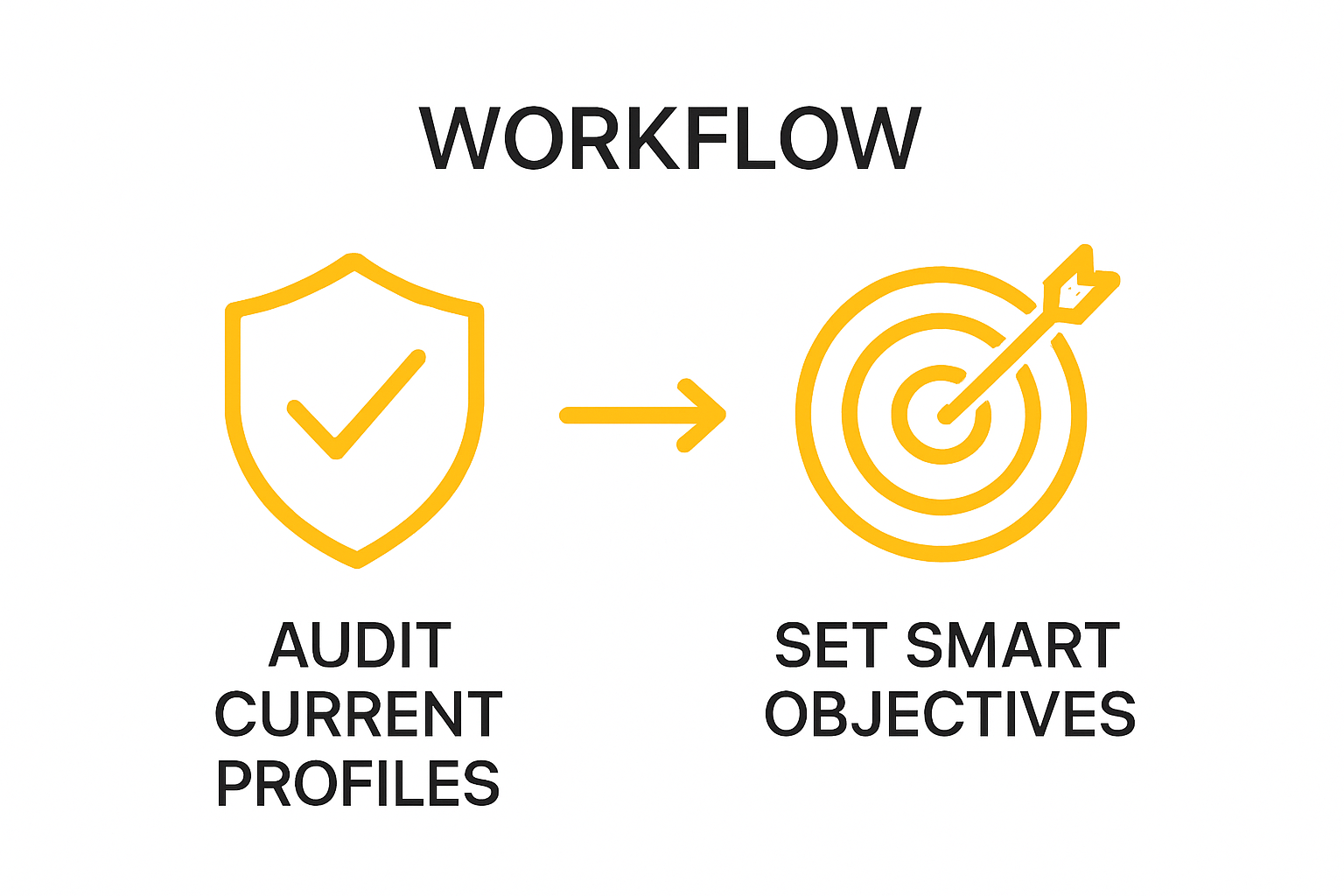Essential Social Media Management Checklist for 2025 Success
- Eddie The Chef

- Sep 25
- 10 min read

Most brands think posting pretty photos is all it takes to win at social media. But the truth is, success comes down to the checklist behind the scenes. Did you know that brands who audit their profiles and set clear goals see up to 25 percent higher engagement than those who play it by ear. Turns out, the real difference between social media chaos and results is knowing exactly what to check before you even hit publish.
Table of Contents
Quick Summary
Key Point | Explanation |
1. Conduct a Thorough Social Media Audit | Review every social media account, analyzing metrics like engagement and consistency to set a baseline for improvement. |
2. Define Clear, SMART Objectives | Establish specific, measurable, achievable, relevant, and time-bound goals aligned with your overall business strategy. |
3. Create and Maintain a Content Calendar | Use a structured calendar to plan and schedule diverse content types, ensuring consistency and audience engagement. |
4. Actively Engage with Your Audience | Respond promptly and genuinely to interactions, fostering relationships and building community trust around your brand. |
5. Regularly Measure and Adjust Strategies | Collect performance data consistently, analyze trends, and adapt your strategy to optimize engagement and meet your objectives. |
Assess Your Current Social Media Presence
Building a robust social media management checklist requires a clear understanding of your current digital landscape. Think of this assessment as your marketing kitchen’s initial ingredient inventory - knowing exactly what you have before crafting your strategic recipe.
Start by conducting a comprehensive audit of all existing social media accounts. Open each platform and systematically review your profiles, noting details like follower count, engagement rates, content consistency, and overall brand representation. Screenshot and document each profile’s current state to create a baseline for future comparison.
Pay special attention to profile completeness and alignment with your brand identity. Examine your profile images, bios, contact information, and link sections. Inconsistent or outdated information can signal neglect to potential customers. Read our guide on understanding social media strategy for deeper insights into strategic profile optimization.
Analyze your content performance metrics using native platform analytics and third-party tools. Key indicators include:
Post reach and impressions
Engagement rates (likes, comments, shares)
Audience demographics
Peak posting times
Content type performance
Look beyond surface-level metrics to understand deeper audience connections. Which posts generate meaningful interactions? What type of content resonates most with your followers? These insights will help refine your social media management approach.
Identify potential gaps in your current social media presence. Are there platforms where your target audience congregates that you haven’t explored? Are your current channels effectively representing your brand’s voice and business objectives? Be honest in your assessment, recognizing both strengths and areas requiring improvement.
Document your findings comprehensively. Create a structured report highlighting current performance, strengths, weaknesses, and initial recommendations. This diagnostic snapshot will serve as a critical reference point for developing your 2025 social media management strategy, ensuring your digital marketing efforts are targeted and purposeful.
Here is a checklist table to help you systematically assess your current social media profiles, ensuring nothing is overlooked during your audit process.
Audit Task | What to Review | Why It Matters |
Profile Completeness | Bio, images, contact info, links | Ensures accuracy and builds trust with your audience |
Brand Consistency | Visuals, messaging, tone | Strengthens brand recognition across all platforms |
Follower Count & Growth | Total followers, recent growth trends | Measures current reach and helps set growth objectives |
Engagement Rate | Likes, comments, shares | Indicates how actively your audience interacts with content |
Content Consistency | Posting frequency, content themes | Maintains audience interest and sets brand expectations |
Audience Demographics | Age, location, interests | Confirms your message is reaching your target market |
Content Performance | Post reach, impressions, top performers | Identifies what types of content resonate most with followers |
Platform Relevance | Platforms used vs target audience | Reveals potential channel gaps for better audience coverage |

Define Clear Objectives for Social Media Management
Defining clear objectives transforms your social media management from random posting to strategic communication. This step acts like a strategic compass, guiding every digital interaction towards meaningful business outcomes. Your objectives will become the foundation of your entire social media approach, determining content, engagement strategies, and measurement criteria.
Begin by aligning your social media goals directly with your broader business strategy. Consider what specific outcomes you want to achieve. Are you looking to increase brand awareness, drive website traffic, generate leads, or build community engagement? Each objective requires a different approach and set of tactics. Learn more about leveraging social media connections to understand nuanced targeting strategies.
Utilize the SMART framework to crystallize your objectives. This means creating goals that are Specific, Measurable, Achievable, Relevant, and Time-bound. Instead of a vague aim like ‘grow followers’, craft a precise objective such as ‘Increase Instagram followers by 25% within six months through targeted content and engagement strategies’.
Consider quantifiable metrics that will demonstrate progress towards these objectives. These might include:
Follower growth rate
Engagement percentage
Click-through rates
Conversion rates
Audience demographic expansion
Dig deeper than surface-level numbers. Understand the story behind the metrics. A high follower count means little if those followers do not represent your target market or engage meaningfully with your content. Quality always trumps quantity in social media management.
Involve key stakeholders in objective setting to ensure alignment across your organization. Your marketing team, sales representatives, and leadership should contribute insights about what success looks like from their perspectives. This collaborative approach ensures your social media objectives serve multiple business functions and create holistic value.
Document your objectives formally, creating a reference document that can be regularly reviewed and adjusted. This living strategy will help your team stay focused, accountable, and adaptive in the fast-changing digital landscape. Remember, effective social media management is not about being everywhere, but about being strategic and intentional in your digital presence.
Create a Content Calendar for Consistency
A content calendar transforms random social media posting into a strategic communication tool. Think of it as your marketing kitchen’s recipe planner - a systematic approach to preparing, scheduling, and serving content that keeps your audience engaged and your brand messaging cohesive. Creating this calendar requires thoughtful planning and a keen understanding of your audience’s preferences and platform dynamics.
Explore our restaurant social media engagement tips to understand how targeted content scheduling can dramatically improve audience interaction. Begin by selecting a digital tool that suits your workflow. Google Sheets, Trello, or specialized social media management platforms like Hootsuite can help you visualize and track your content strategy effectively.
Start by mapping out key dates relevant to your business and industry. This includes product launches, seasonal events, company milestones, and potential campaign periods. These anchor points will help structure your content themes and ensure you’re not caught off guard by important dates. Consider creating a color-coded system that distinguishes between different content types - promotional posts, educational content, behind-the-scenes glimpses, and user-generated content.
Develop a balanced content mix that keeps your audience intrigued and engaged. A typical strategy might include:
Informative posts highlighting industry insights
Behind-the-scenes company culture snapshots
Customer testimonials and success stories
Product or service showcases
Interactive content like polls or Q&A sessions
Research the optimal posting frequency and timing for each social media platform. Instagram might require daily posts, while LinkedIn might work best with 3-4 weekly updates. Use platform analytics to understand when your audience is most active and schedule content accordingly. Allocate specific time blocks for content creation, ensuring you’re consistently ahead of your publishing schedule.
Incorporate flexibility into your content calendar. While planning is crucial, leave room for spontaneous posts that capture real-time moments or respond to current trends. Aim to have 70% planned content and 30% reactive content to maintain a dynamic, responsive social media presence. Review and adjust your calendar monthly, analyzing performance metrics and audience feedback to continually refine your approach.
To help you structure your content planning process, here is a comparison table outlining common content types used in a social media calendar, their main purpose, and suitable platforms.
Content Type | Main Purpose | Best Platforms |
Informative Posts | Share industry insights and tips | LinkedIn, Facebook |
Behind-the-Scenes | Showcase company culture | Instagram, Facebook |
Customer Testimonials | Build trust and highlight success | LinkedIn, Instagram |
Product/Service Showcases | Present offerings and features | Instagram, Facebook |
Interactive Content | Drive engagement (polls, Q&As) | Instagram, Facebook |
User-Generated Content | Feature real customer experiences | Instagram, LinkedIn |
Campaign Announcements | Promote special offers/events | Facebook, Instagram |

Engage with Your Audience Actively
Active audience engagement transforms social media from a broadcasting platform to a dynamic conversation space. Think of your social media channels as a digital gathering place where meaningful interactions build lasting relationships with your community. This step is about creating genuine connections that go beyond surface-level likes and comments.
Respond to comments and messages promptly, treating each interaction as an opportunity to demonstrate your brand’s personality and commitment to customer experience. Aim to reply within 24 hours, showing that you value your audience’s input. Discover how to make significant connections with your target audience to understand the nuanced art of digital communication.
Develop a consistent tone that reflects your brand’s unique voice. Whether you’re playful, professional, or inspirational, maintain authenticity across all interactions. This means crafting responses that sound human, not like a robotic customer service script. Personal touches can transform a standard reply into a memorable interaction that builds brand loyalty.
Implement strategies to encourage active participation from your audience. Consider engagement techniques like:
Running interactive polls
Hosting live Q&A sessions
Sharing user-generated content
Creating challenge-based campaigns
Responding to comments with thoughtful, personalized replies
Move beyond passive monitoring to proactive community building. Seek out conversations related to your industry, even when your brand isn’t directly tagged. Comment on relevant posts, share insights, and position yourself as a knowledgeable contributor in your field. This approach expands your reach and demonstrates your expertise beyond your immediate follower base.
Establish clear guidelines for team members managing social media interactions. Create a comprehensive response framework that outlines how to handle different types of comments - from glowing praise to constructive criticism. Develop a set of principles that prioritize empathy, professionalism, and problem-solving. Train your team to turn potential negative interactions into opportunities for showcasing exceptional customer care.
Track and analyze your engagement metrics regularly. Look beyond surface numbers to understand the quality of interactions. Are your responses generating meaningful conversations? Are followers returning to engage repeatedly? Use these insights to continuously refine your approach, ensuring your social media strategy remains dynamic and responsive to your audience’s evolving needs.
Measure Performance and Adjust Strategies
Measuring social media performance is like conducting a comprehensive health check for your digital marketing strategy. Performance analysis transforms raw data into actionable insights, enabling you to refine your approach continuously. This step is about understanding what works, what doesn’t, and how to evolve your social media management checklist for maximum impact. Learn more about developing a robust marketing strategy to complement your social media performance evaluation.
Establish a consistent reporting framework that aligns with the objectives you previously defined. Choose key performance indicators (KPIs) that directly reflect your original goals. If brand awareness was your primary objective, track metrics like reach, impressions, and follower growth. For engagement-focused goals, prioritize metrics such as comments, shares, and interaction rates.
Utilize both native platform analytics and third-party social media management tools to gather comprehensive data. Each platform offers unique insights - Instagram Insights, Facebook Analytics, and LinkedIn’s analytics dashboard provide nuanced information about your audience and content performance. Cross-reference these platforms to develop a holistic understanding of your social media ecosystem.
Develop a systematic approach to performance evaluation by tracking these critical metrics:
Engagement rate
Follower growth
Click-through rates
Conversion rates
Audience demographics
Content type performance
Optimal posting times
Create a monthly performance review ritual. Set aside dedicated time to analyze your metrics, comparing current performance against previous periods and your initial objectives. Look beyond surface-level numbers to understand the story behind the data. Are certain content types generating more meaningful interactions? Are specific posting times yielding better results?
Implement a continuous improvement cycle that transforms insights into strategic adjustments. If video content consistently outperforms static images, reallocate resources to produce more video content. When you notice engagement dropping during certain times, modify your posting schedule. Treat your social media strategy as a living document that evolves with your audience’s preferences and platform dynamics.
Document your findings and strategic adjustments systematically. Maintain a performance tracking spreadsheet that chronicles your metrics, insights, and subsequent strategy modifications. This historical record will help you identify long-term trends, validate your strategic decisions, and demonstrate the tangible value of your social media management efforts.
Ready to Transform Your Social Media Presence in 2025?
You have just read how an organised social media management checklist can turn random efforts into real results. Yet, many regional businesses still struggle with building a consistent content calendar, measuring true engagement, and making sense of shifting digital trends. If you’ve ever worried your brand voice is getting lost or your ROI is slipping through the cracks, you’re not alone. That’s why at Marketing Recipes Australia, we specialise in cooking up actionable solutions using the very strategies covered in this checklist. We blend hands-on expertise with a unique kitchen-inspired approach to help you cut through the noise and connect with your audience in a way that sticks.

Join dozens of local businesses who have elevated their digital marketing by letting us manage their social media menu from strategic consulting to content creation to robust performance reviews. Visit Marketing Recipes Australia now to discover how our tailored services—like comprehensive marketing strategy consulting and full-spectrum social media management for regional businesses—can give your business the fresh boost it needs this year. Don’t wait for your competitors to get ahead. Reach out today and let’s cook up your 2025 success story.
Frequently Asked Questions
What is the importance of assessing my current social media presence?
Assessing your current social media presence gives you insights into your digital landscape, allowing you to understand your strengths, weaknesses, and areas for improvement. This initial audit serves as a baseline for developing an effective social media strategy for 2025.
How do I set clear objectives for my social media management?
To set clear objectives, align them with your broader business strategy using the SMART framework. Develop goals that are Specific, Measurable, Achievable, Relevant, and Time-bound, ensuring they directly contribute to your overall business outcomes.
What should be included in a social media content calendar?
A social media content calendar should include key dates relevant to your business, a balanced mix of content types (promotional posts, educational information, user-generated content), and optimal posting times for each platform. It should also allow for flexibility to incorporate spontaneous posts.
How can I measure the performance of my social media strategy?
You can measure social media performance by tracking key performance indicators (KPIs) that align with your objectives. These metrics include engagement rates, follower growth, click-through rates, and audience demographics. Establish a regular review schedule to analyse and adjust your strategy based on these insights.
Recommended
Comments